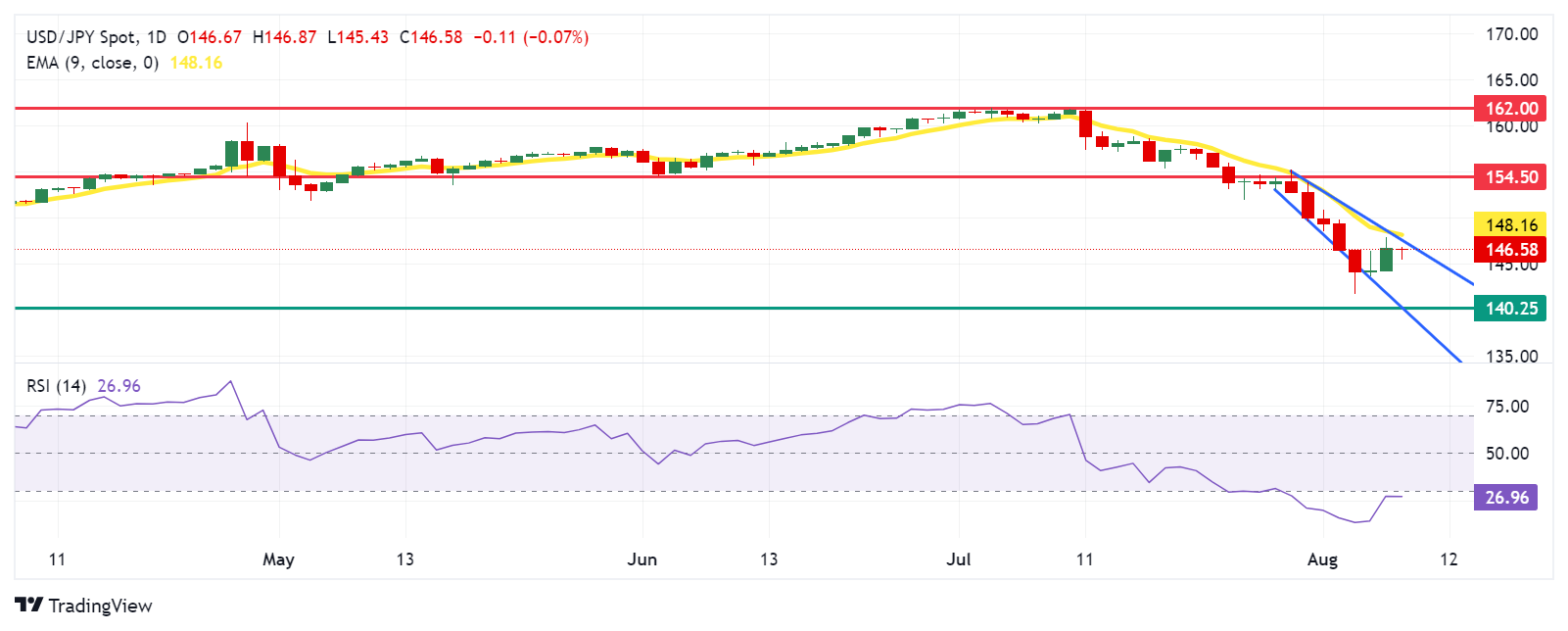- The Japanese Yen edges higher as US Dollar faces challenges due to dovish mood surrounding the Fed.
- BoJ Summary of Opinions emphasizes targeting a neutral rate of "at least around 1%" as a medium-term goal.
- Traders expect a deeper rate cut by the US Federal Reserve in September.
The Japanese Yen (JPY) recovers its daily losses against the US Dollar (USD) on Thursday. However, the USD/JPY pair received support following the comments from Bank of Japan (BoJ) Deputy Governor Shinichi Uchida, who said on Wednesday, “We won’t raise rates when markets are unstable,” according to Reuters.
The Bank of Japan’s Summary of Opinions from the Monetary Policy Meeting on July 30 and 31 showed that several members believe economic activity and prices are progressing as anticipated by the BoJ. The members are targeting a neutral rate of "at least around 1%" as a medium-term goal.
BoJ’s Summary of Opinions: Members see prices and growth developing in line with outlook, read more.
The downside for the safe-haven Yen could be restrained due to the increased risk-off mood amid rising tensions in the Middle East. According to two US intelligence officials, Iran and its allies are preparing for possible retaliation against Israel following the recent killings of a top military commander of Iran’s Hezbollah in Lebanon and a senior Hamas leader in Tehran, as reported by CNN.
The US Dollar (USD) faces challenges as traders expect a deeper rate cut by the US Federal Reserve (Fed) in September. According to the CME FedWatch tool, there is now a 72.0% probability of a 50-basis point (bps) interest rate cut by the Fed in September, up from 11.8% a week earlier.
Daily Digest Market Movers: Japanese Yen receives pressure after remarks from BoJ’s Uchida
- Japan’s Finance Minister Shunichi Suzuki stated on Thursday that he is “closely watching volatile stock movements but is not in the phase of taking actual action.” Suzuki noted that decisions regarding monetary policy are the responsibility of the Bank of Japan and emphasized that they are monitoring market developments closely, according to Reuters.
- Japan’s Current Account surplus decreased to ¥1,533.5 billion ($10.47 billion) year-on-year in June, from ¥2,849.9 billion prior. This was below market expectations of a surplus of ¥1,790 billion.
- On Wednesday, BoJ Deputy Governor Shinichi Uchida also noted that BoJ's interest rate strategy will adapt if market volatility alters economic forecasts, risk assessments, or projections. Given recent market volatility, he emphasized the need for careful monitoring of the economic and price impacts of their policies, stating, “We must maintain the current degree of monetary easing for the time being.”
- Japan’s Chief Cabinet Secretary Yoshimasa Hayashi stated on Tuesday that “wage increases are expected to extend to part-timers and small businesses by autumn, supported by strong Shunto results and minimum wage hikes.”
- Japan’s Labor Cash Earnings data showed a 4.5% year-on-year increase in average income for June, surpassing both the previous 2.0% and the expected 2.3% readings. This is the highest increase since January 1997, reinforcing Japan's transition toward a rising interest rate environment.
- According to Reuters, Federal Reserve Bank of San Francisco President Mary Daly expressed increased confidence on Monday that US inflation is moving towards the Fed's 2% target. Daly noted that “risks to the Fed's mandates are becoming more balanced and that there is openness to the possibility of cutting rates in upcoming meetings,” according to Reuters.
- The minutes from the Bank of Japan's June meeting showed that some members expressed concerns about rising import prices due to the recent decline in the JPY, which could pose an upside risk to inflation. One member noted that cost-push inflation might intensify underlying inflation if it results in higher inflation expectations and wage increases.
Technical Analysis: USD/JPY consolidates around 146.50
USD/JPY trades around 146.50 on Thursday. The daily chart analysis shows that the pair consolidates within a descending channel, suggesting a bearish bias. Additionally, the 14-day Relative Strength Index (RSI) is remaining below 30, signaling a short-term rebound.
Regarding support, the USD/JPY pair may test the lower boundary of the descending channel around a throwback support at the 140.25 level, which was recorded in December.
In terms of resistance, the USD/JPY pair tests the upper boundary of the descending channel, aligned with the nine-day Exponential Moving Average (EMA) around the 148.15 level. A breakout above this level could reduce bearish momentum and enable the pair to test the "throwback support turned resistance" at 154.50.
USD/JPY: Daily Chart
Japanese Yen PRICE Today
The table below shows the percentage change of Japanese Yen (JPY) against listed major currencies today. Japanese Yen was the strongest against the US Dollar.
| USD | EUR | GBP | JPY | CAD | AUD | NZD | CHF | |
|---|---|---|---|---|---|---|---|---|
| USD | -0.13% | -0.07% | -0.54% | -0.16% | -0.53% | -0.13% | -0.24% | |
| EUR | 0.13% | 0.07% | -0.38% | -0.06% | -0.41% | 0.00% | -0.12% | |
| GBP | 0.07% | -0.07% | -0.48% | -0.13% | -0.49% | -0.08% | -0.19% | |
| JPY | 0.54% | 0.38% | 0.48% | 0.35% | -0.00% | 0.37% | 0.27% | |
| CAD | 0.16% | 0.06% | 0.13% | -0.35% | -0.35% | 0.04% | -0.07% | |
| AUD | 0.53% | 0.41% | 0.49% | 0.00% | 0.35% | 0.41% | 0.29% | |
| NZD | 0.13% | -0.01% | 0.08% | -0.37% | -0.04% | -0.41% | -0.12% | |
| CHF | 0.24% | 0.12% | 0.19% | -0.27% | 0.07% | -0.29% | 0.12% |
The heat map shows percentage changes of major currencies against each other. The base currency is picked from the left column, while the quote currency is picked from the top row. For example, if you pick the Japanese Yen from the left column and move along the horizontal line to the US Dollar, the percentage change displayed in the box will represent JPY (base)/USD (quote).
Japanese Yen FAQs
The Japanese Yen (JPY) is one of the world’s most traded currencies. Its value is broadly determined by the performance of the Japanese economy, but more specifically by the Bank of Japan’s policy, the differential between Japanese and US bond yields, or risk sentiment among traders, among other factors.
One of the Bank of Japan’s mandates is currency control, so its moves are key for the Yen. The BoJ has directly intervened in currency markets sometimes, generally to lower the value of the Yen, although it refrains from doing it often due to political concerns of its main trading partners. The current BoJ ultra-loose monetary policy, based on massive stimulus to the economy, has caused the Yen to depreciate against its main currency peers. This process has exacerbated more recently due to an increasing policy divergence between the Bank of Japan and other main central banks, which have opted to increase interest rates sharply to fight decades-high levels of inflation.
The BoJ’s stance of sticking to ultra-loose monetary policy has led to a widening policy divergence with other central banks, particularly with the US Federal Reserve. This supports a widening of the differential between the 10-year US and Japanese bonds, which favors the US Dollar against the Japanese Yen.
The Japanese Yen is often seen as a safe-haven investment. This means that in times of market stress, investors are more likely to put their money in the Japanese currency due to its supposed reliability and stability. Turbulent times are likely to strengthen the Yen’s value against other currencies seen as more risky to invest in.
Information on these pages contains forward-looking statements that involve risks and uncertainties. Markets and instruments profiled on this page are for informational purposes only and should not in any way come across as a recommendation to buy or sell in these assets. You should do your own thorough research before making any investment decisions. FXStreet does not in any way guarantee that this information is free from mistakes, errors, or material misstatements. It also does not guarantee that this information is of a timely nature. Investing in Open Markets involves a great deal of risk, including the loss of all or a portion of your investment, as well as emotional distress. All risks, losses and costs associated with investing, including total loss of principal, are your responsibility. The views and opinions expressed in this article are those of the authors and do not necessarily reflect the official policy or position of FXStreet nor its advertisers. The author will not be held responsible for information that is found at the end of links posted on this page.
If not otherwise explicitly mentioned in the body of the article, at the time of writing, the author has no position in any stock mentioned in this article and no business relationship with any company mentioned. The author has not received compensation for writing this article, other than from FXStreet.
FXStreet and the author do not provide personalized recommendations. The author makes no representations as to the accuracy, completeness, or suitability of this information. FXStreet and the author will not be liable for any errors, omissions or any losses, injuries or damages arising from this information and its display or use. Errors and omissions excepted.
The author and FXStreet are not registered investment advisors and nothing in this article is intended to be investment advice.
Recommended content
Editors’ Picks

EUR/USD targets yearly highs beyond 1.1100
Significant losses in the US Dollar allow EUR/USD to edge closer to its yearly highs, comfortably trading beyond the 1.1100 level after US inflation and jobs data releases.

GBP/USD meets a decent barrier near 1.2950
GBP/USD secures its third straight day of gains, smashing well past the 1.2900 yardstick and reaching new weekly highs, fueled by the increasing selling pressure in the Greenback.

Gold looks consolidative around $3,130 after US data
Following US data releases, Gold prices now seem to have embarked on a consolidative range near the $3,130 mark. This robust performance comes amid a pronounced bearish bias in the Greenback and mixed US yields.

Cardano stabilizes near $0.62 after Trump’s 90-day tariff pause-led surge
Cardano stabilizes around $0.62 on Thursday after a sharp recovery the previous day, triggered by US Donald Trump’s decision to pause tariffs for 90 days except for China and other countries that had retaliated against the reciprocal tariffs announced on April 2.

Trump’s tariff pause sparks rally – What comes next?
Markets staged a dramatic reversal Wednesday, led by a 12% surge in the Nasdaq and strong gains across major indices, following President Trump’s unexpected decision to pause tariff escalation for non-retaliating trade partners.

The Best brokers to trade EUR/USD
SPONSORED Discover the top brokers for trading EUR/USD in 2025. Our list features brokers with competitive spreads, fast execution, and powerful platforms. Whether you're a beginner or an expert, find the right partner to navigate the dynamic Forex market.




